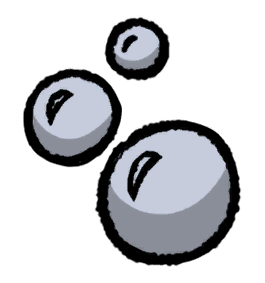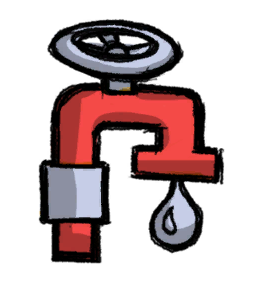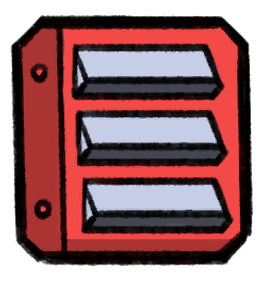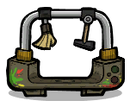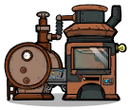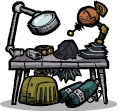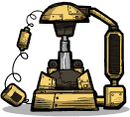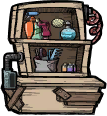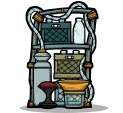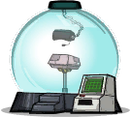Farm Station
Jump to navigation
Jump to search
Farm Station produces Micronutrient Fertilizer to give Farmer's Touch modifier to one plant, which doubles the plant growth speed for 1 cycle + 0.1 cycles for every level of the dupe's Agriculture skill (e.g. a Farmer with +15 Agriculture will provide a 2.5 cycle Farmer's Touch modifier).
Assigned Duplicants must possess the Crop Tending skill (the second level of farming) to craft and apply Micronutrient Fertilizer.
This building creates a Greenhouse room.
Tips
- Mealwood, Wheezewort, and Oxyfern cannot be boosted, nor can Decor plants only plantable in Flower Pots and similar.
- Wild plants can also be boosted, effectively doubling their growth rate to 50% of domestic growth.
- The Farm Station provides Agriculture XP. Applying Farmer's Touch provides Machinery XP.
- Duplicants can operate a Farm Station even in a Greenhouse room with no plants. They will then take the Micronutrient Fertilizer to any plants that need it, provided those plants are also in a Greenhouse room.
- If the Greenhouse with plants is inhospitable or far from resources, the Farm Station in it can be set at low priority (but not disabled), to allow duplicants to deliver the Micronutrient Fertilizer to that room without crafting it there.
- Note, however, that only one Micronutrient Fertilizer can be produced at a time per Farm Station. Duplicants will also often craft a single Micronutrient Fertilizer, go and fertilize a plant, and then return to craft another, sometimes causing significant travel delays.
- Duplicants will still fertilize a plant even it is ready to harvest or not currently growing due to environmental conditions or missing irrigation/fertilization, so prioritize harvesting to avoid wasting fertilizer (and plant growth time, for that matter).
Analysis
- The output of a single Fertilizer Synthesizer provides enough Fertilizer to boost 14.4 plants continuously, increased by +10% for each level of Agriculture of the Farmer(s) applying Farmer's Touch.
- Each Micronutrient Fertilizer requires 41.667s of Fertilizer Synthesizer time, and costs 2.708 kg of Dirt, 1.083 kg of Phosphorite, and 1.625 kg of Polluted Water.
- The cost of creating the necessary 5kg of Fertilizer using a Fertilizer Synthesizer is almost always cheaper, in terms of resources consumed per plant harvest, than feeding the crop for another cycle.
- The resources needed for the Fertilizer Synthesizer are relatively common and easily produced:
- Dirt can be produced from Pips, an Ethanol Distiller via composting, or heating Algae/Slime or feeding it to Pacu and composting the resulting Polluted Dirt. If Dirt is the limiting resource, note that Fertilizer itself can be heated to 125 °C to produce Dirt 1:1, which can then be turned back into more Fertilizer, at the cost of the other two resources.
- Phosphorite is excreted by Dreckos, though ranching requires either domesticated Mealwood (which costs substantial additional Dirt per cycle, 30 kg/cycle per Drecko), Balm Lily, or Pincha Pepper, or 4 times as many plants planted wild (and thus without resource cost).
- Polluted Water can sourced from Lavatories, Showers, and Sinks, but note that the Food Poisoning germs are not destroyed by the Fertilizer Synthesizer, and are instead transferred to the Fertilizer. Polluted Water can also be sustainably produced from Carbon Skimmers, Algae Distillers, and both Natural Gas Generators and Petroleum Generators (including ones run off of the Ethanol produced by an Ethanol Distiller also used to generate Dirt!)
- For plants that consume one or more of the same resources as the Fertilizer Synthesizer, if boosted every single cycle, the net change in average resource cost per plant growth cycle (ie. per harvest, assuming no harvest delay) compared to unboosted growth is (percentages change per harvest noted for plant's normal resource costs):
- Pincha Pepper: +10.83 kg/harvest Dirt, +0.33kg/harvest Phosphorite (+4.17%), -133.50 kg/harvest Polluted Water (-47.68%)
- Sleet Wheat: -20.63 kg/harvest Dirt (-22.92%), +9.75 kg/harvest Phosphorite, +14.63 kg/harvest Polluted Water, -180 kg/harvest Water (-50%)
- Nosh Sprout: -24.06 kg/harvest Dirt (-22.92%), +11.37 kg/harvest Phosphorite, +17.06 kg/harvest Polluted Water, -210 kg/harvest Ethanol (-50%)
- Thimble Reed: +2.71 kg/harvest Dirt, +1.08 kg/harvest Phosphorite, -158.38 kg/harvest Polluted Water (-49.49%)
- All these figures are improved even more if the Farmer has an Agriculture skill above 0, which is to be expected as a typical Duplicant with the Crop Tending skill required to apply Farmer's Touch will have at least +5 Agriculture thus reducing fertilizer use by at least 33%.
- Arbor Tree: Only trunk can be boosted, so no harvest advantage to boosting
- Mealwood: Cannot be boosted
- For all other plants, boosting the plant halves the resource cost per harvest of any solid and liquid consumed by the plant, but adds the full cost of the Fertilizer ingredients multiplied by the harvest cycles of the plant.
- Note that per cycle resource cost per plant is not decreased by fertilization. However, one only needs ~half as many plants for the same average production per cycle, so for a given per cycle production rate, the above modifiers also hold true.
- Note that the Fertilizer Synthesizer also outputs 10 g/s of Natural Gas.
- This can be used to fuel a Natural Gas Generator with 11.11% uptime, which itself produces 67.6 g/s of Polluted Water and 22.5 g/s of Carbon Dioxide while active.
- Average production rate is 7.5 g/s of Polluted Water, which offsets 19.23% of the Polluted Water consumption of the Fertilizer Synthesizer.
- This produces an average of 88.89 W of power, or 133.33 W if boosted, offsetting most or all of the 120 W power consumption of the Fertilizer Synthesizer itself.
- This also produces an average of 2.5 g/s of Carbon Dioxide, which while small, is 7.5% of the Carbon Dioxide needed by a Slickster or its Molten Slickster cousin, converting 50% of its mass to either Crude Oil, which can be refined into Petroleum (potentially producing more Natural Gas), or Petroleum directly. Consuming this in a Petroleum Generator will generate additional power, additional Carbon Dioxide, and additional Polluted Water.


